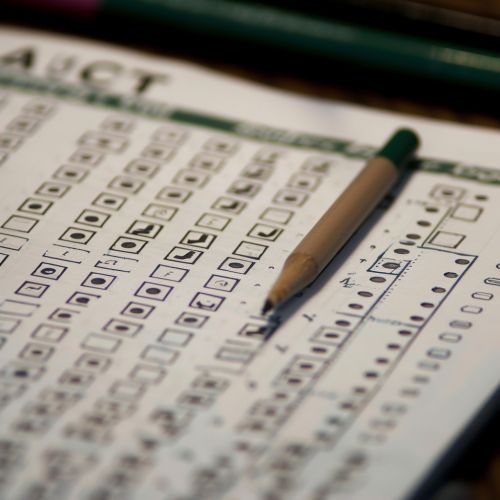ACT: Difference between revisions
(Created page with "== Overview == The ACT (American College Testing) is a standardized test used for college admissions in the United States. It was first introduced in November 1959 by University of Iowa professor Everett Franklin Lindquist as a competitor to the Scholastic Aptitude Test (SAT). The ACT originally consisted of four tests: English, Mathematics, Social Studies, and Natural Sciences. In 1989, the Social Studies test was changed into a Reading section (which included a social...") |
No edit summary |
||
| (One intermediate revision by the same user not shown) | |||
| Line 2: | Line 2: | ||
The ACT (American College Testing) is a standardized test used for college admissions in the United States. It was first introduced in November 1959 by University of Iowa professor Everett Franklin Lindquist as a competitor to the Scholastic Aptitude Test (SAT). The ACT originally consisted of four tests: English, Mathematics, Social Studies, and Natural Sciences. In 1989, the Social Studies test was changed into a Reading section (which included a social sciences subsection), and the Natural Sciences test was renamed the Science Reasoning test, with more emphasis on problem-solving skills. | The ACT (American College Testing) is a standardized test used for college admissions in the United States. It was first introduced in November 1959 by University of Iowa professor Everett Franklin Lindquist as a competitor to the Scholastic Aptitude Test (SAT). The ACT originally consisted of four tests: English, Mathematics, Social Studies, and Natural Sciences. In 1989, the Social Studies test was changed into a Reading section (which included a social sciences subsection), and the Natural Sciences test was renamed the Science Reasoning test, with more emphasis on problem-solving skills. | ||
[[Image:Detail-77635.jpg|thumb|center|A close-up of a multiple-choice ACT test booklet.|class=only_on_mobile]] | |||
[[Image:Detail-77636.jpg|thumb|center|A close-up of a multiple-choice ACT test booklet.|class=only_on_desktop]] | |||
== Test Structure == | == Test Structure == | ||
Latest revision as of 20:32, 6 May 2024
Overview
The ACT (American College Testing) is a standardized test used for college admissions in the United States. It was first introduced in November 1959 by University of Iowa professor Everett Franklin Lindquist as a competitor to the Scholastic Aptitude Test (SAT). The ACT originally consisted of four tests: English, Mathematics, Social Studies, and Natural Sciences. In 1989, the Social Studies test was changed into a Reading section (which included a social sciences subsection), and the Natural Sciences test was renamed the Science Reasoning test, with more emphasis on problem-solving skills.


Test Structure
The ACT is divided into four multiple-choice subject tests: English, Mathematics, Reading, and Science reasoning. Subject test scores range from 1 to 36; all scores are integers. The English, Mathematics, and Reading tests also have subscores ranging from 1 to 18 (the subject score is not the sum of the subscores). In addition, students taking the optional writing test receive a writing score ranging from 2 to 12 (this is a change from the previous 1–36 score range); the writing score does not affect the composite score.
English
The first section is the 45-minute English test covering usage/mechanics and rhetorical skills. The 75-question test consists of five passages with various sections underlined on one side of the page and options to correct the underlined portions on the other side of the page. Specifically, questions focus on usage and mechanics – issues such as commas, apostrophes, (misplaced/dangling) modifiers, colons, and fragments and run-ons – as well as on rhetorical skills – style (clarity and economy of expression), strategy, transitions, and organization (sentences in a paragraph and paragraphs in a passage).
Mathematics
The second section is the 60-minute, 60-question math test with 14 covering pre-algebra, 10 elementary algebra, 9 intermediate algebra, 14 plane geometry, 9 coordinate geometry, and 4 elementary trigonometry questions. The difficulty of questions usually increases as you get to higher question numbers. Calculators are permitted in this section only. The calculator requirements are stricter than the SAT's in that computer algebra systems (such as the TI-89) are not allowed; however, the ACT permits calculators with paper tapes, that make noise (but must be disabled), or that have power cords with certain "modifications" (i.e., disabling the mentioned features), which the SAT does not allow. Standard graphing calculators, such as the TI-83 and TI-84, are allowed.
Reading
The reading section is a 35-minute, 40-question test that measures reading comprehension. The reading test consists of four sections, three of which contain one long prose passage and one which contains two shorter prose passages. The passages are representative of the levels and kinds of text commonly encountered in first-year college curricula. This reading test assesses skills in three general categories: key ideas and details, craft and structure, and integration of knowledge and ideas. Test questions will usually ask students to derive meaning from texts referring to what is explicitly stated or by reasoning to determine implicit meanings.
Science
The science section is a 35-minute, 40-question test. There are seven passages each followed by five to seven questions. There are three Data Representation passages with 5 questions following each passage, 3 Research Summary passages with six questions each, and one Conflicting Viewpoints passage with 7 questions.
Scoring
The ACT is scored on a 1 to 36 point scale. The scores are then averaged together for a final composite score. The composite score is often used by colleges to determine a student's admission eligibility. In addition to the composite score, the ACT also provides test takers with a percentile rank for each of the four tests, as well as a composite percentile rank. This rank compares a student's performance on the ACT with that of all other test takers.
Preparation
Preparation for the ACT can take on various forms. Some students choose to self-study using ACT prep books while others may prefer to enroll in an ACT prep course. There are also online resources available, including practice tests, tutorials, and interactive games. The ACT organization also provides a booklet called "Preparing for the ACT" which includes a complete practice test, along with answer keys and scoring instructions.
Use in College Admissions
The ACT is one of the two main tests used in the college admissions process in the United States, the other being the SAT. The ACT is accepted by all four-year colleges and universities in the U.S. The ACT measures knowledge and skills in subject areas that are considered important for success in first-year college courses.
